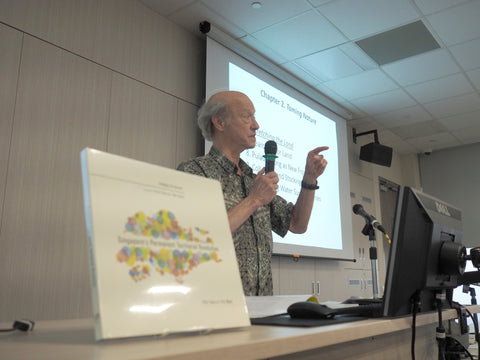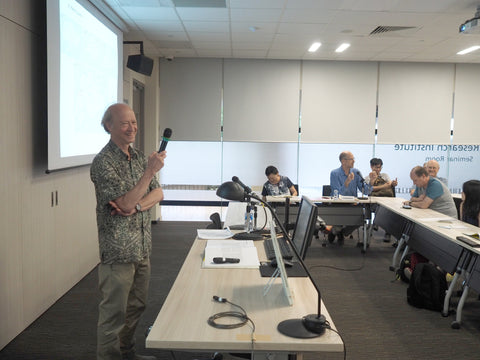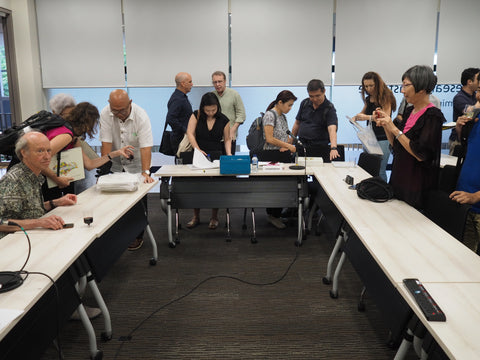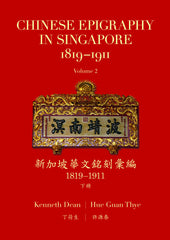News
Follow NUS Press on
Five Minutes with Samuel Ling Wei Chan May 15, 2019 09:42
I n April this year, Dr Samuel Ling Wei Chan published "Aristocracy of Armed Talent, The Military Elite in Singapore". It explores the Singapore Armed Forces by a comprehensive and in-depth examination of its elite leadership: the 170 men (and a very few women) who served or serve as flag officers, that is generals or admirals. How did Singapore build a culture of leadership for its armed forces? What role did the SAF Scholars scheme, introduced in 1971, play in forming this culture?For this edition of Five Minutes With... we turned to noted military expert and journalist David Boey, who conducted this interview and first ran it on his excellent blog on Singapore military matters, Senang Diri. Thanks to David for the interview and for giving us permission to run it on the website.
n April this year, Dr Samuel Ling Wei Chan published "Aristocracy of Armed Talent, The Military Elite in Singapore". It explores the Singapore Armed Forces by a comprehensive and in-depth examination of its elite leadership: the 170 men (and a very few women) who served or serve as flag officers, that is generals or admirals. How did Singapore build a culture of leadership for its armed forces? What role did the SAF Scholars scheme, introduced in 1971, play in forming this culture?For this edition of Five Minutes With... we turned to noted military expert and journalist David Boey, who conducted this interview and first ran it on his excellent blog on Singapore military matters, Senang Diri. Thanks to David for the interview and for giving us permission to run it on the website.
How long did it take you to write the book?
The book is a revised and updated edition of my PhD thesis. I started my studies in March 2011 but by February 2012 it was apparent that my initial topic (on military education in Australia and the US) was not tenable.
What made you press on with research on the SAF despite initial hurdles?
It was a challenge to complete a puzzle and I was focused on the task at hand. The topic is interesting to me, both in academic and general terms.
What was the most challenging aspect of the research for this book?
The most challenging aspects were access to information in terms of open source material and interviews for the specific questions that I had in mind.
How did you go about resolving the challenge(s)?
The 28 interviews were great and a blessing in terms of being able to get the work done.
Which chapter did you enjoy researching/writing most?
I must say I enjoyed them all due to the variation, focus, and information in each of the chapters.
What are the takeaways you hope the reader will glean from the book?
To appreciate the SAF in its entirety, both the good, the quirky, and the not so good.
Who is this Jacques de Coutre the Prime Minister speaks of? January 30, 2019 11:01
From Prime Minister Lee Hsien Loong's speech launching the Singapore Bicentennial: "Around 1630, two centuries before Stamford Raffles, de Coutre proposed to the King of Spain to build a fortress in Singapore, because of its strategic location. Had the King accepted de Coutre’s proposal, Singapore might have become a Spanish colony, instead of a British one."Five Minutes with Andrea Benvenuti June 21, 2017 12:00
 With the recent publication of his new book, Cold War and Decolonisation: Australia’s Policy towards Britain’s End of Empire in Southeast Asia, Andrea Benvenuti seeks to challenge popular views—and misconceptions—of Australian relations with its neighbouring region during the Cold War. Moreover, Benvenuti, a senior lecturer in International Relations and European Studies at the University of New South Wales, offers a fresh and incisive look at the Australian perspective during the emergence of independent Southeast Asian nations and the collapse of British colonial rule.
With the recent publication of his new book, Cold War and Decolonisation: Australia’s Policy towards Britain’s End of Empire in Southeast Asia, Andrea Benvenuti seeks to challenge popular views—and misconceptions—of Australian relations with its neighbouring region during the Cold War. Moreover, Benvenuti, a senior lecturer in International Relations and European Studies at the University of New South Wales, offers a fresh and incisive look at the Australian perspective during the emergence of independent Southeast Asian nations and the collapse of British colonial rule.
In this edition of Five Minutes With …, Dr Benvenuti debunks the myths surrounding Australian political history, particularly those regarding the Menzies government, transplants his Cold War observations into the current political climate, and shares his upcoming projects.
What attracted you to the Australian policy perspective of the Cold War?
One of the enduring myths in Australian political history is that Australia failed to pursue an independent foreign policy in Asia during the early Cold War. As the story goes, under the Liberal–Country Party Coalition government of Sir Robert Menzies (1949–66) Australia overplayed the threat of international communism and became closely aligned with the United States and Britain in an effort to contain the spread of communism in Asia. However, by identifying itself too closely with American and British Cold War policies in Asia, the Menzies government, it is said, foreclosed any chance of engaging meaningfully with its neighbouring region and of developing a distinctive regional role for Australia. The underlying assumption here is that Australia would probably have been better off pursuing a neutralist foreign policy.
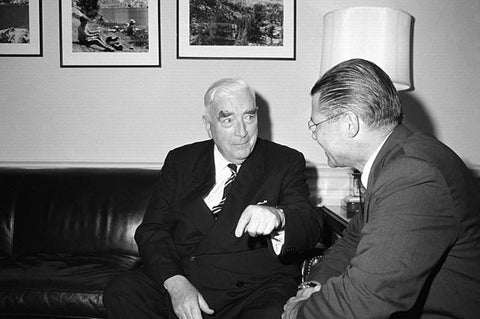
Robert Menzies (left) meets with US Secretary of Defence Robert McNamara at the Pentagon in 1964
(Image credit: Wikimedia Commons).
I have never been persuaded by these kinds of arguments and I thought I ought to find out more. I hope my book will provide a less distorted appreciation of Australia’s Cold War role in Asia and thus make a significant contribution to a better understanding of Australian policy concerns and interests, in a region of paramount strategic, political and economic importance.
What insights does your book offer on Australian foreign policy and relations with Southeast Asia that other historians may have neglected?
Another enduring myth in Australian history and politics is the idea that the Menzies years stand as a blot on the relationship between Australia and Southeast Asia. In Australian universities, scores of undergraduate and postgraduate students are taught to believe that Menzies’ conservative government had little interest in forging close and enduring links with Southeast Asia. According to the prevailing academic wisdom (one that is often embraced with gusto by the Australian media), Menzies’ Anglophilia and his keenness to nurture close ties with Australia’s ‘great and powerful friends’ (the US and Britain) prevented Australia from developing closer regional ties. Only with the arrival of Gough Whitlam at The Lodge (the Australian Prime Minister’s residence in Canberra) in 1972 did Australia begin to seriously engage with the region.
Nothing, of course, could be farther from the truth and my book shows just how grotesque this view is. Under Menzies, Australia pursued a policy of active and sustained regional engagement. Southeast Asia’s political stability and economic prosperity were of utmost importance to Menzies’ Australia, and the Liberal–Country Party government acted accordingly by placing regional engagement at the forefront of its foreign policy.
A clip of Gough Whitlam’s 1974 visit to the Philippines, which was part of a Southeast Asian tour to strengthen ties between the region and Australia. Whitlam also visited Singapore, Malaysia, Thailand, Laos, and Burma. (Source: Whitlam Institute YouTube Channel; footage courtesy of the National Film and Sound Archive and the National Archives of Australia [NAA 4423/31]).
The Menzies government expressed approval of Malaya and Singapore’s bids for merger and independence from British rule. How has this endorsement shaped Australia’s relations with Malaysia and Singapore since the Cold War era?
It has no doubt contributed to drawing Australia closer to Malaysia and Singapore, and forging an enduring and deep relationship with them.
In light of increasing nationalism amongst certain world powers, what lessons on navigating security and international relations from your book might be applicable today?
It is often difficult to compare the world of the 1950s or 1960s with our own. When I talk to my undergraduate students about the early Cold War years in Southeast Asia, I sometimes feel as if I am talking to them about ancient history, given that so much has changed at international and regional levels since then. With this proviso in mind, I venture to offer one possible lesson: as the history of modern Singapore and Malaysia clearly shows, regional political stability and economic prosperity are best maintained through a continuing and robust Western engagement with the region and vice-versa. Beijing’s version of ‘Asia for the Asians’ is really in no one’s interest.
What are your current research projects?
I am currently working on two projects: the first deals with Western (American, British and Australian) responses to the emergence of non-alignment in Asia during the 1950s and early 1960s. The second examines the role and impact of Western military power and strategic foreign policy in the ordering and re-ordering of Asia between 1919 and 1989. It is a collaborative international project sponsored by the Department of History at the National University of Singapore and led by Professor Brian Farrell.
The Challenges of Mapping Singapore’s Permanent Territorial Transformations June 2, 2017 14:30
On May 29, Professor Rodolphe De Koninck launched his latest book, Singapore’s Permanent Territorial Revolution: Fifty Years in Fifty Maps, at the National University of Singapore’s Asia Research Institute. As the third book in a series of Professor De Koninck’s noted atlases—the first was released in 1992, and the second, in 2008—the event saw a huge turnout consisting of local artists, students, heritage advocates, and established local academics.
(Image credit: Sebastian Song)
Professor De Koninck described his early fascination and subsequent research on farmers and vegetable traders in a post-colonial Singapore. He related how his series of atlases was borne out of an unnerving sense of displacement he felt as a returning researcher, having lost his bearings many times in a constantly developing Singapore. In particular, he recalled being struck by the aspirations of his Singaporean friends who, despite having their daily lives dramatically altered by the massive urban transformations of the late 20th century, had taken in all these changes without complaint.
“No other city in the world experiences such rapid and systematic transformations.”
(Image credit: Sebastian Song)
Comparing the urban developments that have unfolded in capitals across the world, Professor De Koninck declared that the territorial evolutions of Singapore are of an unprecedented scale, subsequently proposing the hypotheses at the heart of his book: (1) the resignation of Singaporeans towards socio-economic transformations are in part due to the permanent transformations of the urban landscape, and more importantly, (2) the transient nature of local spaces allows for only a single dimension of territorial allegiance: that of the Singaporean state.
“Nothing is sacred, nothing is permanent, nothing is culturally untouchable.”
(Image credit: Patricia Karunungan)
Bringing the audience into a preliminary view of his book, Professor De Koninck presented the nature of territorial alienation faced by Singaporeans through a vast and fascinating series of maps. These included: the diachronic mapping of changes in the population spread, the distribution of religious places of worship, military training grounds, burial sites and the like. The constant marginalisation, and in some cases, destruction, of culturally sacred spaces, he argued, has precipitated a cultural phenomenon in which “nothing is sacred, nothing is permanent, nothing is culturally untouchable”.
Throughout the talk, Professor De Koninck also debunked several myths—such as that of land scarcity—and raised keen observations surrounding changes in the territoriality and topography of Singapore, such as the non-intentional softening of violent urban transformations in the effervescence of nature alongside roads.
(Image credit: Sebastian Song)
At the end of the talk, Professor De Koninck and members of the audience engaged in a heated Q&A session where they grappled with issues surrounding territory and topography, the alienation of heritage and history from individuals, as well as the politics of identity.
(Image credits: Sebastian Song)
In light of the increasing and galvanising public outcry surrounding the demolition of sites such as Bukit Brown Cemetery, the lessons to be gleaned from Singapore’s Permanent Territorial Revolution, in particular, its comprehensive insights into a Singapore rarely remembered, are now more relevant than ever.
The book is available for purchase in-store at NUS Press and on our online webstore.
Author Events: Ann Wee and Rodolphe De Koninck May 19, 2017 12:00
We’re pleased to announce that two NUS Press authors will be having events in Singapore towards the end of May.
Meet Ann Wee at Kinokuniya (May 27)
Mrs Ann Wee, author of A Tiger Remembers: The Way We Were in Singapore,  will be appearing at Kinokuniya Main Store (Ngee Ann City) on Saturday, May 27 at 4pm.
will be appearing at Kinokuniya Main Store (Ngee Ann City) on Saturday, May 27 at 4pm.
Born in the year of the Tiger, Ann Wee moved to Singapore in 1950 to marry into a Singaporean Chinese family. Affectionately observed and wittily narrated, A Tiger Remembers: The Way We Were in Singapore brings to life Singapore’s social transformation.
A finalist for ‘Best Non-Fiction Title’ for the 2017 Singapore Book Awards, this book captures the things that Ann Wee remembers but history books have left out – questions of hygiene, terms of endearment, the emotional nuance in social relations, rural clan settlements, migrant dormitories, and more.

(Image credit: Ann Wee)
Admission is free—just drop by the Kinokuniya Main Store at 4pm next Saturday!
Talk by Prof Rodolphe De Koninck: The Challenges of Mapping Singapore’s Permanent Territorial Transformations (May 29)
Rodolphe De Koninck will be presenting a talk at the Asia Research Institute at the National University of Singapore on Monday, May 29, 4 – 6.30pm.
Over a period of nearly 25 years, Singapore’s territorial transformations have  been the object of three atlases by Professor De Koninck. The first appeared in 1992, the second in 2008, and Professor De Koninck’s latest book, Singapore’s Permanent Territorial Revolution: Fifty Years in Fifty Maps will be published at the end of the month.
been the object of three atlases by Professor De Koninck. The first appeared in 1992, the second in 2008, and Professor De Koninck’s latest book, Singapore’s Permanent Territorial Revolution: Fifty Years in Fifty Maps will be published at the end of the month.
Ever since Singapore became an independent nation in 1965, its government has been intent on transforming the island’s environment. This has led to a nearly constant overhaul of the landscape, whether still natural or already manmade. No stone is left unturned, literally, and, one could add, nor is a single cultural feature, be it a house, a factory, a road or a cemetery.
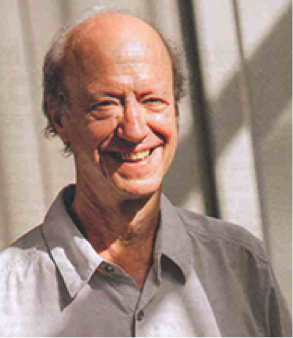
(Image credit: Wilson Pang)
By constantly “replanning” the rules of access to space, Professor De Knoninck shows that the Singaporean State has been redefining territoriality, even in its minute details. This is one reason it has been able to consolidate its control over civil society, peacefully and to an extent rarely known in history.
The talk will be devoted to the presentation of how Singapore’s Permanent Territorial Revolution was produced and, more importantly, to a summary and explanation of its contents and conclusions.
Admission is free but you are encouraged to register your interest with the Asia Research Institute.
Two NUS Press Titles Shortlisted for the 2017 Singapore Book Awards April 7, 2017 10:00
We are pleased that two NUS Press titles have been shortlisted for two categories in this year’s Singapore Book Awards.
Best Non-Fiction Title Finalist
A TIGER REMEMBERS: THE WAY WE WERE IN SINGAPORE
 In A Tiger Remembers, Ann Wee, born in the Year of the Fire Tiger, pays homage to the things history books often deem insignificant — questions of hygiene, terms of endearment, the emotional nuance in social relations, stories of ghost wives and changeling babies, rural clan settlements and migrant dormitories, the things that changed when families moved from squatter settlements into public housing.
In A Tiger Remembers, Ann Wee, born in the Year of the Fire Tiger, pays homage to the things history books often deem insignificant — questions of hygiene, terms of endearment, the emotional nuance in social relations, stories of ghost wives and changeling babies, rural clan settlements and migrant dormitories, the things that changed when families moved from squatter settlements into public housing.
Affectionately observed and wittily narrated, with a deep appreciation of how far Singapore has come, this book brings to life the story of social change through a focus on the institution of the family. The late S. R. Nathan is "certain that this memoir will be absorbed in society and will serve as a conversation piece to learn about the various aspects of our past heritage and culture."
Best Illustrated Non-Fiction Title
CHINESE EPIGRAPHY IN SINGAPORE, 1819-1911
The history of Singapore's Chinese community has been carved in stone and wood throughout the country. Professor Kenneth Dean and Dr Hue Guan Thye's Chinese Epigraphy in Singapore, 1819-1911 looks specifically at 62 Chinese temples, native place associations, clan and guild halls, where epigraphs were made between 1819 to 1911 are still found today. Over the course of four years, Professor Dean and Dr Hue visited more than 400 locations to record, photography, analyse and translate these inscriptions into English. These epigraphs are now faithfully reproduced with more than 1,300 illustrations in these two volumes.
The Singapore Book Awards is an industry award for books published in Singapore. Into its third edition, the awards shine the spotlight on the quality of published works and celebrate the achievements of the local publishing industry.
This year’s award winners will be announced at an Awards Ceremony at Pan Pacific Singapore on April 20, 2017. For more information about the Singapore Book Awards and other award categories, click here.
Five Minutes with Ronald McCrum February 24, 2017 10:00
This year marks the 75th anniversary of the Fall of Singapore. Considered one of the greatest defeats in the history of the British Army during World War Two, retired British Army Officer and military historian, Ronald McCrum, undertakes a close examination of the role and the responsibilities of the colonial authorities in his new book, The Men Who Lost Singapore, 1938-1942.
Considered one of the greatest defeats in the history of the British Army during World War Two, retired British Army Officer and military historian, Ronald McCrum, undertakes a close examination of the role and the responsibilities of the colonial authorities in his new book, The Men Who Lost Singapore, 1938-1942.
In this edition of Five Minutes With ..., we talk to Colonel McCrum to get his insights on how his military background helped his research, his history and ties with Southeast Asia, and whether co-ordination between civil authorities and military bodies has improved nearly eight decades on.
How did you come to be interested in the military history of this particular region?
My interest in military history was, I suppose, inevitable. At 18 years of age, I decided to become a soldier and at Sandhurst, the officer training college, part of the curriculum is military history and it fascinated me. In any case, it was now my chosen profession and I almost felt duty bound to understand something of the trials and tribulations of my predecessors.
The Far East, Malaya/Malaysia and Singapore were of particular interest because I spent a lot of my life in these parts. I first came to the area not long after the end of the war (1948/49?)—my father was then stationed in Nee Soon. We lived just outside Johor Bahru and I went to ‘English College’ in Johor Bahru. After a period in England, we returned to Malaya, this time to Kuala Lumpur (KL) and I went to Victoria Institution in KL. So the formative years of my life were in this part of the world.

McCrum in Germany (Iserlohn), 1981
(Image credit: Ronald McCrum)
In your book you discuss the various factors leading up to Singapore’s downfall, particularly how the preparation and execution of British defence strategies were addled by the conflicting views, interests and priorities of the military and civil authorities. In what ways has your military experience allowed you to be more attuned to these issues?
In 1965, after I had been a commissioned officer in the British Army for a number of years, an opportunity arose to be seconded for a period to the Malaysia Armed Forces and I accepted. I was sent to the Malaysian Military College at Sungei Besi just outside KL as an instructor. While in Malaysia my first two sons were born, the first shortly after we arrived and the second just before we returned to UK. And then surprisingly in 1970 after completing a year’s course at the British senior officers Staff College I was sent to Singapore as the Assistant Defence Advisor to the British High Commissioner. Where I spent two and half very happy years and my third and last son was born there. All three boys have Southeast Asia in their blood.
You’ve pointed out the civil authorities were slow to recognise the impending threat of the Japanese invasion. Was this general across other European colonies in Southeast Asia, or was it particular to Singapore? Do you think issues of co-ordination between civil authorities and military bodies improved with the advent of new technologies and procedures of co-ordination today?
While in Malaysia/Singapore I was endlessly curious about how the British Forces were so easily beaten in 1941/42. And in my travels I took the chance to visit the scenes of the battles that took place. After much reading, I began to recognise that in those early days of a new form of mobile modern warfare no one escaped an enveloping invasion. Inclusive lessons of total war were quickly learnt in the West, but in the quiet backwater of South East Asia such a prospect seemed remote. Glaringly obvious afterwards was the need for a combined (civil and military) planning headquarters, with an overall supremo able to impose decisions. At that time the three military services had each their own HQ’s in different locations in Singapore and the Governor was remote in Government House. Now of course a combined planning authority is normal greatly helped, of course, by modern communications. I cannot think of a current example where the civil and military authorities do not work closely together towards a common aim. A good instance in the Far East, after the war, was the combined operations of all the authorities in Malaya planning the defeat of the communist terrorists during the Malayan Emergency.

McCrum in Israel, 1988
(Image credit: Ronald McCrum)
What also struck me as grossly negligent was the poor, indeed almost non-existent, liaison between the Colonial Office and the War Office in London. One was demanding increased production of tin and rubber and the other telling the military they had to employ local labour to prepare defences. The same labour that was required on the rubber estates and the tin mines. There were of course a number of other very important factors that played a crucial part in the defeat, but the authorities quarrelling on basic matters like this did not help.
What are your future plans? Are you thinking of writing another book?
I am well into researching another book. This time a biography of a significant British figure who played an important part during the Indian Mutiny of 1857.

McCrum in Singapore with an advance copy of
The Men Who Lost Singapore in early February 2017
(Image credit: Pallavi Narayan)
Sayonara, 2016 Singapore Writers Festival November 18, 2016 17:00
With Japan as its country focus, the 19th Singapore Writers Festival came to an end last weekend after ten action-packed days of literary talks, discussions, music, and performances.
NUS Press was proud to have been one of five publishers featured in The Paper Trail, a backroom tour of Singapore publishers led by poet Yong Shu Hoong on November 5. Our director Peter Schoppert addressed a group of about 30 people and gave a quick overview of the history of the university press, and how it came to establish a foothold in the academic publishing scene in Asia.

(Image credit: Caroline Wan, National Arts Council)
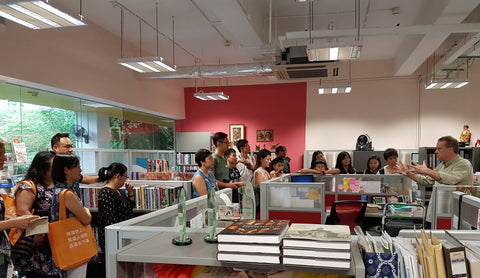
(Image credit: Yong Shu Hoong)
Author Yap’s poems and short stories, and Goh Poh Seng’s memoir and novel, If We Dream Too Long, were naturally snapped up by some tour participants.

(Image credit: Caroline Wan, National Arts Council)
On November 6, two of our authors, Lim Cheng Tju, co-author of The University Socialist Club and the Contest for Malaya: Tangled Strands of Modernity, and Mrs Ann Wee, author of A Tiger Remembers: The Way We Were in Singapore, appeared on a panel alongside Nilanjana Sengupta at the Asian Civilisations Museum to share how everyday experiences, lesser-known stories, and oral histories are crucial for a better understanding of Singapore's past.
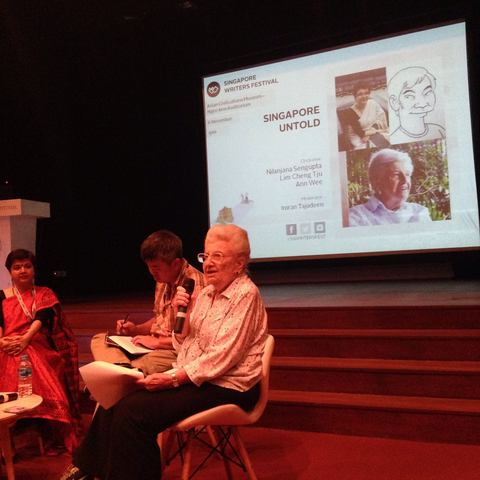
(From left to right) Nilanjana Sengupta, Lim Cheng Tju and Ann Wee
(Image credit: Chye Shu Wen).
Last but not least, we caught the matinee performance of The Finger Players’ love-letter to Singapore’s literary history, Between the Lines: Rant and Rave II. It was a delight to watch Serene Chen and Jean Ng act out key literary milestones in the development of Singapore’s cultural landscape. We were thrilled to have had some of our publications and authors (Edwin Thumboo, Arthur Yap and Goh Poh Seng to name just a few) featured in this play.

(Image credit: Chye Shu Wen)
At the end of the play, the stage became a pop-up shop for 30 minutes and it was heartening to see audience members stream down to the stage to browse through and purchase the books that were featured in the play.
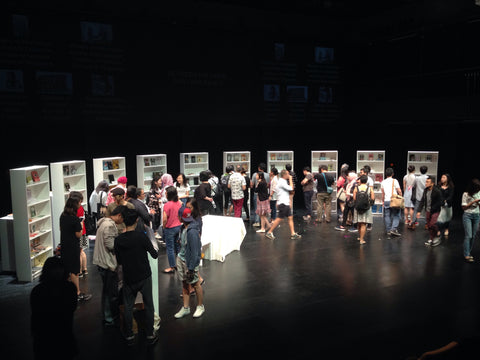
(Image credit: Chye Shu Wen)
We look forward to the 20th edition of the Singapore Writers Festival, which is set to take place from 2–13 November 2017.

Launch of "Nature's Colony" at the Singapore Botanic Gardens October 21, 2016 11:00
Timothy Barnard launched his latest book, Nature’s Colony: Empire, Nation and Environment in the Singapore Botanic Gardens, at the Singapore Botanic Gardens on October 14, as part of the Gardens' regular speaker series.


(Photos courtesy of Sebastian Song)
Professor Barnard centred his talk around the history of the Gardens and its broader impact beyond its bounadries in environmental, political, and
social terms.


(Photos courtesy of Sebastian Song)
Professor Barnard explained that the botanic gardens was established as a private park between 1869 and 1874. By the early 1870s, the British realised that it had the potential of becoming a key colonial institution because imperial botany was seen as a tool that could strengthen empire (i.e. rubber seeds could be harvested in Singapore and Malaya, which could then be traded as a commodity).
The ever-changing position of the Singapore Botanic Gardens in society and politics over time has also often been overlooked: Professor Barnard emphasised the Gardens' precarious position as a colonial institution in a decolonialising society in a post-Merdeka era.
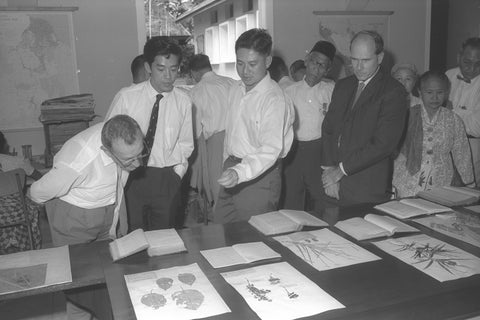
Humphrey Burkill, Director of the Singapore Botanic Gardens from 1957 to 1969, leading a tour of government officials at the opening of the “renovated” herbarium in October 1964 (Source: Ministry of Information and Arts Collection, courtesy of the National Archives of Singapore).
One of the highights of the talk was a segment on Henry Ridley, the Director of the Singapore Botanic Gardens between 1888 and 1912. Ridley was seen as “mad” by many of his contemporaries within the colonial government in Singapore due to his quirks and views of how the Singapore Botanic Gardens should be developed.
Ridley accomplished a lot during his tenure as director—from overseeing the set up of a short-lived zoo (1875-1905), to the establishing an Economic Garden within the park. Ridley also had the foresight to see that planting oil palm would have economic advantages for the region.

Henry Ridley with a small panther (Image reproduced with the kind permission of the Board of Trustees of the Royal Botanic Gardens, Kew).
The talk was followed by a lively question and answer session that was moderated by the Group Director of the Singapore Botanic Gardens, Dr Nigel Taylor.

(Photo courtesy of Sebastian Song)
At the end of the talk, many queued up patiently for Barnard to sign their copies of Nature’s Colony.



(Photos courtesy of Sebastian Song)
We would like to thank the Singapore Botanic Gardens for hosting the launch. If you would like to hear snippets of what Barnard said that day, you can check out his interview with talkshow host, Michelle Martin, on 93.8 Live’s Culture Café here, where he discussed his book and the history of the Gardens.
International Translation Day: Five Minutes with Frank Palmos September 30, 2016 09:20
Why does translation matter?
The rise of works being translated into English in recent years seems to have made that question a rhetorical one, and it is clear that English readers are becoming more interested in literary and non-fiction works that have been written in different languages.
The rousing reception towards translated non-fiction work, like Thomas Piketty’s bestseller, Capital in the 21st Century (translated by Arthur Goldhammer), and literary works like this year’s Man Booker International winner, Han Kang’s The Vegetarian (translated by Deborah Smith), shows that translators are set to take on a more major role in the world of publishing.
To celebrate International Translation Day, which falls on 30 September every  year, we caught up with Frank Palmos, the acclaimed journalist, historian, and translator of works such as Bao Ninh’s award-winning The Sorrow of War, and more recently, Revolution in the City of Heroes, a first-hand account of Indonesian nationalists’ efforts to gain independence from the Dutch in Surabaya in 1945. Here, Dr Palmos shares his experience of translating and why translations are important for the preservation of memory and history.
year, we caught up with Frank Palmos, the acclaimed journalist, historian, and translator of works such as Bao Ninh’s award-winning The Sorrow of War, and more recently, Revolution in the City of Heroes, a first-hand account of Indonesian nationalists’ efforts to gain independence from the Dutch in Surabaya in 1945. Here, Dr Palmos shares his experience of translating and why translations are important for the preservation of memory and history.
Translators have been said to be literary activists, given that they play such a strong role in facilitating the travel of stories across borders of language. Can you tell us more about your experience in translating fiction (The Sorrow of War) and non-fiction (Revolution in the City of Heroes)?
The “borders” my languages had to cross borders were very local indeed. I was born in a tiny timber town in Central Victoria and schooled in a tiny one-roomed, six-class school of rarely more than 35 pupils, which was rated a hardship post for teachers, resulting in a rapid turnover of teachers and accents, from harsh Australian to middle-England or Northern Ireland.
My Irish-descended Australian-born mother, who spoke faultless, wonderfully clear English, married a Greek born man who never did master English (so he spoke with a Greek accent), and I learnt to both imitate and understand at a very early age. My neighbours were Scot-born, tough country folk whose harsh accents were also a good training for me. By the time I was ten years of age, I could entertain my classmates and certain adults by imitating all these accents.
The two books that you have translated deal with very heavy topics such as ideological battles and wars of independence. What draws you to translate stories like this?
I won a United Nations (UN) sponsored Fellowship in Djakarta (as it was known then) in 1961, administered by the Indonesian Foreign Office. Part of the reward was being able to live with Indonesian families of my choosing, which helped me learn about Indonesian people and their habits from early morning until late at night. I soon discovered almost every Indonesian spoke a regional language and Bahasa Indonesia, the national language. Hence I began to speak and mentally translate Sundanese as well as Indonesian when with my first family in Bandung.
I enjoyed listening to President Sukarno speak so much that I studied hard to attain a level that gave me confidence to request a position as an unofficial translator of President Sukarno’s annual August 17 Independence Day speeches. I was given the requisite passes to the Merdeka Palace and permission to hook up my headphones to an old National radio set.

President Sukarno (Source: Wikimedia Commons).
I was placed about 25 metres behind the president, facing away from him and towards the large assembly of diplomats and foreign press. I gave a passable simultaneous translation of his 1961 Independence Day speech. I hardly
remembered a word of it, but others said I got almost one half of the speech correct, without missing any important dot points. Sukarno often repeated his main points, which helped. Years later, my UN interpreter colleagues comforted me by saying they, too, hardly remembered any of their simultaneous translations. The brain switches itself into automatic translation gear.
I found that I liked doing that work and particularly enjoyed answering the telephone in my hosts’ Jakarta homes, successfully conversing without the callers knowing I was a foreigner, although once, Deputy Prime Minister Johannes Leimena called with a message for my host and upon ending the call, asked if my parents were Dutch. “I think I hear a little Dutch accent,” he said.
How has your background in journalism helped in translating?
The first reason I was comfortable writing the English Version of Bao Ninh’s book was that my original translator of my 1990 book, Ridding the Devils, Madame Hao, was a very reliable technical translator. The second reason was that I did not regard The Sorrow of War as fiction, nor frankly did Bao Ninh, although he had to clothe his stories in certain make belief vignettes. Ridding the Devils was non-fiction, so I wrote Sorrow of War using the same depth of knowledge gained on 33 land, sea and air missions, as a Vietnam War correspondent.
Usually, foreign correspondents do not learn the languages of the countries they report. It is one of the great failings that still exists throughout the western world today, where publishers rarely place correspondents abroad for more than three or four years and do not interest themselves in funding language training or cultural adaptation. I funded my own fare to Indonesia in the days when a flight to Djakarta was the equivalent to AUD $5,000 return today, on a BOAC Comet.
My interest in Indonesia began in 1961 and will continue until I die. I find no difficulty in retaining my love for Australia, Greece, France, and Singapore, for that matter, where I lived in the dramatic years during the formation (and partial break-up) of Malaysia. But as an historian, I find it my duty to repay the hospitality and friendship of the Indonesian people.
In the Sukarno years (1950–1965) research into the foundations of the Republic were not welcomed because the President felt that “nation building” was more important, and by nation building he meant that to keep the peace he did not wish to place greater credit on one ethnic group over another. The role of Surabaya and East Javanese was not accentuated, yet that was where the Republic finally won a small piece of territory for the fledgling Republic at a time when independence seemed an eventuality many years off.
I have used my research and translation skills and my past friendships with Indonesian leaders, many of whom were founders of the Republic, to write the complete history of the founding of the Republic in 1945. It was printed last week in Bahasa Indonesia, titled Surabaya 1945: Sakral Tanahku (Surabaya 1945: Sacred Territory).

Surabaya after the uprisings on 31 October 1945 (Source: Universities Kristen Petra; this photo is part of the collections at the Imperial War Museum).
However, Revolution in the City of Heroes—the Suhario Padmodiwiryo (alias "Hario Kecik") diary that is known as Student Soldiers in its original form in Bahasa Indonesia—is an important part of Indonesia’s history and of that Surabaya story. Unless I had worked with the author (General Suhario) until his death in December 2014, that history would have been lost. In years to come this generation of modern Indonesians will look back and be thankful that works like Kecik’s are in their National Archives.
Five Minutes with Nicholas Herriman September 23, 2016 15:00
If you thought witch-hunts were a thing of the 17th cenutry, think again.
In 1998, around 100 people were killed for being sorcerers in Banyuwangi, Indonesia. This figure far outnumbers the number of people who were executed during the Salem witch trials of 1692–1693, where 200 were put on trial and 20 were executed.
Nicholas Herriman, a senior lectuerer in Anthropology at La Trobe 
University, set out to find out why the killings happened as part of research for his PhD thesis between 2000-2002. His findings and arguments about the Banyuwangi incident are presented in his latest book, Witch-Hunt and Conspiracy: The ‘Ninja Case’ in East Java. We caught up with Dr Herriman to talk about witch-hunts, why anthropology is an important discipline in the study of culture and society, and his interest in podcasts (and making them).
Were the sorcerer killings in Banyuwangi the first cases to pique your interest in witchcraft and magic?
Honestly, yes! Prior to learning about the killings, my interest in Indonesia had focused on cultural performance and literature. I first heard about the sorcerer killings in 1998. The killings troubled by me. I wondered, “How could there be a witch-hunt in modern times?” I also thought, “Who was behind the killings? Who benefitted from the killings?”
These questions, it turned out, were naïve and misplaced. But I asked myself these kinds of questions. Arriving in the field in 2000, I still assumed that the witch-hunt had nothing to do with magic, but was rather tied up with national political interests. While doing fieldwork (2000–2002), I began to realise that witchcraft and magic were crucial to understanding the killings. That was the first time my interest was piqued.

In Southeast Asia today, is the belief and practice of black magic and sorcery still very common?
As far as I can tell, belief in and practice of black magic and sorcery are very common. We could qualify that statement, as academics are wont to do, by questioning what we mean by “belief”, “practice”, “magic”, and “sorcery”. Nevertheless, studies from different parts of the region report on widespread suspicions. People suspect that their neighbour, colleague, rival, or whoever it might be draws on extraordinary or unseen powers for immoral ends. The people suspected are from the heights of power to the poorest and disenfranchised.
What were the challenges you faced during your field work in Banyuwangi when you undertook the task of conducting over 100 interviews for ethnographic research?
Professionally, the fieldwork was easy. People readily admitted to killing suspected sorcerers. Indeed, in some cases, they boasted and overstated their roles! By contrast, I struggled, personally. Initially I was horrified—I had to deal with ill health and exhaustion. I kept going primarily because I thought it was crucial to get an accurate historical record this massacre; especially as press and academic reports were so misleading. I wrote Witch-hunt and Conspiracy with this objective in mind.
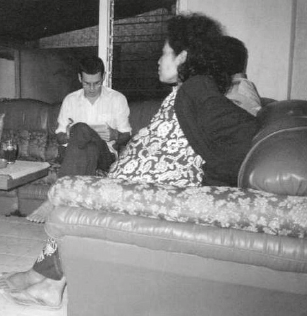
This woman believed she had been ensorcelled. Her protruding stomach is visible from the profile. Dr Herriman is in the background. (Photo courtesy of L. Indrawati)
What are your thoughts about interdisciplinary studies? Upon reading your book, one can see that the historical and political contexts are very important to explaining how local dynamics or reactions to a situation came about (I.e., In your book, the context of 1998 being a period of Reformasi was very important in explaining how locals were reacting to political and social change after the fall of the Suharto government).
My feeling is that context is crucial in all studies of culture and society. Nevertheless, when I compare the anthropological approach with the interdisciplinary approach, I can discern differences in how to treat this context. Based on my fieldwork, the first book I wrote is called The Entangled State. I wrote this as an anthropologist. I was concerned with how the official treatment of the “problem of sorcery” in Banyuwangi could relate to anthropological theories about the state. I contended that the state was entangled in local communities. Because of this, I argued, senior bureaucrats are hamstrung in trying to contain the “problem of sorcery”.
Witch-hunt and Conspiracy is the second book I have written from my research on the sorcerer killings. I have focused closely on the killings themselves and attempted to understand them as an interplay between local dynamics and larger developments. I see this book as an interdisciplinary study in an area studies tradition. I like a diversity of approaches. The paradox of knowing the world is that each different understanding brings both insights and limitations. So I see pros and cons to both anthropological and interdisciplinary area studies.
So how did your academic background shape the way you approached the killings?
As a philosophy student I was introduced to the skepticism of David Hume and others. I was profoundly disturbed by questions about how we know what we think we know. Of course, I have no greater insight into these problems than most people. So the skeptical attitude remained with me. In research and writing Witch-hunt and Conspiracy, I continually challenged and questioned myself. In fact, after months and months of fieldwork the patterns of the killings began to seem clearer to me. I had begun to feel there was no conspiracy behind the killings. Yet I still did not trust appearances. So, for instance, when I interviewed people I would ask, “So who was behind the conspiracy?” Assuming that the truth remains hidden from me was my modus operandi in researching Witch-hunt and Conspiracy. I wanted, as much as possible, to be sure of my findings.
You are known as the “Audible Anthropologist”, having done a podcast series about anthropological concepts. What got you thinking about doing a podcast series as a way of promoting anthropology as a field of discipline and interest? And are you thinking of doing another season of podcasts, or a new series of podcasts?
I teach anthropology at university. Some of my students coming into second year subjects are new to anthropology. I wanted a quick and easy introduction to anthropological concepts. What I found online seemed more suitable for advanced learners. So I decided to produce a crash course myself. I asked La Trobe’s Matt Smith what to do. Matt currently produces La Trobe’s Asia Rising podcasts and other publications. Matt suggested a series of podcasts entitled “The Audible Anthropologist”. I then set myself a target of recording on a concept every workday for 25 days. This would stop me from over-complicating the content. Matt also got me studio time, told me how to record, and he edited the files. I hope that the result is a simplified introduction that even high school students could use. I got great feedback about that series, so I already have another series of podcasts on iTunesU. It’s called “Witch-hunts and Persecution”. This presents an anthropological view on past and present witch-hunts. It is part of my attempt to understand what I have presented in Witch-hunt and Conspiracy, in relation to witch-hunts internationally and throughout history.
Ann Wee's 90th Birthday and the Pre-Launch of Her Book, "A Tiger Remembers" August 24, 2016 17:30
On August 19, the NUS Faculty of Arts and Social Sciences’ Department of Social Work celebrated Mrs Ann Wee’s 90th birthday at NUSS Kent Ridge Guild House. With Minister for Social and Family Development Tan Chuan-Jin as a special guest, the afternoon proved to be a delightful one that served as a retrospect on Mrs Wee’s contributions to the field of social work in Singapore. As one of the country’s pioneer social work educators and longest serving Head of Department of Social Work, she has inspired many in the profession with her philosophy and outlook towards the field.
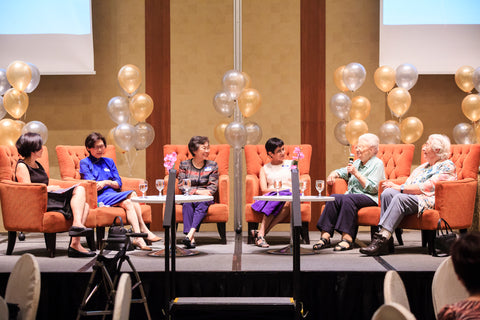
From left to right: Professor Esther Goh (Head of Department of Social Work), Professor Chan Heng Chee, Mrs Lee Wang Cheng Yeng, Dr Sudha Nair, Mrs Ann Wee and Mrs Jean Marshall. (Image credit: Lionel Lin)
The event also marked the pre-launch of her forthcoming NUS Press book, A Tiger Remembers: The Way We Were in Singapore.

(Image credit: Lionel Lin)
Born in the Year of the Fire Tiger, Mrs Wee moved to Singapore in 1950 to marry into a Singaporean Chinese family and was ushered into a world of cultural expectations and domestic rituals that she eventually came to love. Her work in Singapore’s fledging social welfare department that decade only deepened her cross-cultural learning and appreciation for the shapes and forms of the Singapore family. These experiences and “things that the history books left out” are affectionately observed and wittily narrated by Mrs Wee in her book.

Mr John Ang, Senior Fellow at the Department of Social Work, gave a preview of A Tiger Remembers. (Image credit: Lionel Lin)

Mrs Wee presented an autographed cover of A Tiger Remembers to Minister Tan. (Image credit: Lionel Lin)
The afternoon ended with Minister Tan presenting the Ann Wee NUS Social Work Alumni Award to three awardees, and a birthday cake-cutting ceremony.
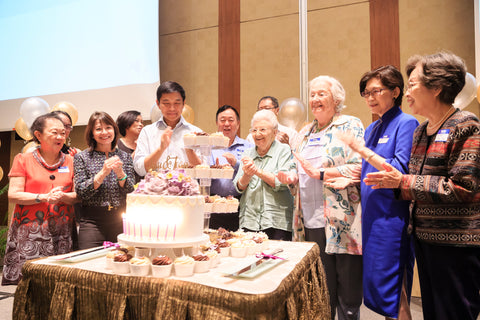
(Image credit: Lionel Lin)
A Tiger Remembers will be available in all good bookstores in October 2016. Mrs Wee will be donating her royalties to the Faculty of Arts and Social Sciences Student Advancement Scholarship Fund.
Five Minutes with Stefan Huebner August 8, 2016 14:30
 With the Rio Olympic Games underway, we caught up with Stefan Huebner, author of Pan-Asian Sports and the Emergence of Modern Asia, 1913-1974 to discuss who was responsible for spreading Western sports across Asia, how sports came to shape the idea of Asian 'nation-states', and why sporting events continue to be an important (and very costly) tool for nation-branding today.
With the Rio Olympic Games underway, we caught up with Stefan Huebner, author of Pan-Asian Sports and the Emergence of Modern Asia, 1913-1974 to discuss who was responsible for spreading Western sports across Asia, how sports came to shape the idea of Asian 'nation-states', and why sporting events continue to be an important (and very costly) tool for nation-branding today.
How did you become interested in the connections between religion, East-West politics and sports?
During my undergraduate studies in history, I was very interested in Japan since it managed to defeat Russia in the Russo-Japanese War of 1904/05. I also wondered why China and other Asian countries became victims of “Western” (and also Japanese) colonialism and imperialism. When we talked about the book, I should say that I was at first not really interested in sports, but when I learned that the Far Eastern Championship Games had been founded by officials of the North American YMCA and supported by the US colonial administration in the Philippines, this really caught my interest. I bet most people think that the International Olympic Committee was mainly responsible for spreading Western sports in Asia and other regions, but that’s not the case. While doing some initial research, I also became very interested in development policy in Asia during decolonisation and the Cold War, which is very important to understand the postwar Asian Games and why they served to communicate the image (actually several different images) of a “rising Asia”.

How is sport related to ideas of anti-colonialism or nationalism? Do these ideas expire?
Very often athletes represent nation-states. Events can be (and some are) organised in different ways, but when the North American YMCA founded the Far Eastern Championship Games in 1913, they chose this approach. Watching athletes representing entities such as “China”, “Japan”, or the “Philippines” in the stadium or reading about them in newspapers created feelings of national belonging. Part of this was based on the YMCA’s and the US colonial administration’s experience of pitting town teams in the Philippines against each other. The intention had been that such athletic rivalry would encourage the selection of athletes based on their competence, not on clan and family relations or other factors, to maximise each team’s strength. In the process, people of different social backgrounds or even ethnicities would be integrated into the town’s team. This approach was then repeated on the regional level, meaning that people from different parts of China, Japan and the Philippines were represented in the respective “national” teams. This integrative approach certainly made it easier for spectators to identify with a team. The intention thus was not to encourage aggressive forms of nationalism (though the outcome sometimes was different), but to encourage the emergence of national civil societies. The staging of the games also regularly served to promote a certain image of the host nation—this remains true today and I doubt this will change in the near future.
Anti-colonialism, both in the form of nationalism and pan-Asianism, was closely linked to all that. Initially, the main organisers of the games were all Americans, who held these positions since there were no Asians who were equally experienced in Western sports. However, when a first generation of Asian physical educators emerged, these often felt patronised and eventually ended this “colonial” relationship between “American experts” and “Asian pupils”. Events on the international level, such as the Paris Peace Conference in 1919, also intensified anti-colonial sentiments—as a newspaper cartoon in my book shows. Seen before the background of this “Asiatisation” process, the games started to communicate the message that Asians now were in charge of a “modernisation process” in fields such as sport, public health and citizenship training that would eventually end the power asymmetry vis-à-vis the “West”.
Asian leaders in the 1910s such as JAAA president Kanō Jigorō criticised American style sports for its characteristics (“inefficient training method for shaping better soldiers and workers”), but did they also consider sports an invasion of “Western” values?
Some indeed did. Especially those Asian leaders who did not appreciate the activities of missionary groups resisted the YMCA’s Christian approach to amateur sports: “muscular Christianity”. However, not all of those Asian leaders rejected Western sports in general, but some of them claimed that they fitted well into Asian cultural backgrounds. There were, for example, Japanese sports leaders who connected Western sports to the Bushidō, the Way of the Warrior. Some of them did this to challenge the influence of North American missionary groups in Asian sports events.
Others, who were closer to the YMCA, advocated an interpretation of the Bushidō that had quite a “Western-Christian” touch. In this way, local resistance against “muscular Christianity” could be circumvented and “Western” values could still be promoted. Much more can be said about this topic, but I want to conclude with shortly mentioning those Asian leaders who eventually dominated the field: those who referred to the Olympic movement and “Olympism”. Doing this became increasingly popular, since such a secular approach to “Western” sports did not cause much resistance (after all, nobody believes in the old Greek gods anymore).
"Uncle Sam teaching the Asian children sports values"; Philippines Free Press (10 May 1919). (Image courtesy of US Library of Congress)
What was the process of penning Pan-Asian Sports and the Emergence of Modern Asia 1913–1974 like?
It is my first book, so I was very enthusiastic when it finally got published. I started working on the topic in autumn 2009 and the book came out this year, which is quite quick, I think.
During the first years I travelled a lot in Asia, Europe and North America to gather sources in various archives and libraries and to make myself familiar with the history of sports in Asia. Turning all these into a book was a fascinating process, especially when I realised how useful the concept of the “civilising mission” is to analyse the events I covered. Scrutinising the games’ connections to Asian nationalisms, pan-Asian sentiments, religious ideas and Cold War development policy was also very interesting as I noticed the tremendous changes the Games experienced over the course of 60 years. I also enjoyed working with so many images—and when my book manuscript was accepted without any revisions, I was extremely happy! Obviously, some less exciting tasks were inevitable … when things needed to be standardised, the bibliography needed to be compiled, etc.
How do you think sports have evolved in Asia in recent years? Do you think the same tensions remain?
It obviously depends on the type of event we talk about. The 18th Asian Games that are set to take place in Indonesia in 2018 is an interesting case, since the event originally was supposed to have taken place in Vietnam. Financial problems, including the question of what to do with the newly-built venues after the event is over, have been a main reason for Vietnam’s decision not to host the games and remind us of how expensive the hosting of regional sports events has become. In my book, I pointed out that the founders of the Asian Games reflected on this problem early on.
When we talk about the Olympic Games, it is remarkable that we will have the Winter Olympic Games in South Korea in 2018, and in China in 2022. Between the two events, the Summer Olympics will take place in Tokyo in 2020. This is very noteworthy, especially since all three East Asian countries have hosted Olympic events before—strictly speaking they are the only Asian countries which have hosted the Olympic Games so far. This again reminds us of the high costs of hosting such events and throws the spotlight on which countries are trusted by the International Olympic Committee to host the Games. The controversial 2010 Commonwealth Games in India comes to one’s mind as it did not set the precedent of hosting any editions of the Olympic Games.

Chinese female swimmers at the 10th Far Eastern Championship Games in 1934. (Image courtesy of Harvard Yenching Library)
Is your next research project along the tangent of politics, religion and sports?
My next book project will be on oceanic colonisation projects, such as offshore drilling, mariculture (farming of marine organisms) and floating city extensions. There is a connection to development policy, which is part of the main story in the later chapters of my book. But I will also continue working on the dynamics between politics, religion and sports. For example, I am co-organising a conference here in Singapore at the Asia Research Institute on 25–26 August titled “The Protestant Ethic and the Spirit of the Social Gospel in Asia, c. 1890s–1930s” where we will have some presentations on sports and the YMCA.
Alfred Russell Wallace the “forgotten” hero: Why is Darwin more famous than Wallace? October 2, 2015 17:01
Ask the man on the street about natural selection, and you are bound to hear the name Charles Darwin. Indeed, it would be easy to conclude from this that Darwin is the de facto founder of natural selection as a concept. Yet, in recent years many have pointed to the concomitant, independent discovery of natural selection by Darwin’s contemporary, Alfred Russell Wallace, and lament the paltry amount of credit accorded to him.
Dr John van Wyhe, a historian of science at NUS and the editor of The Annotated Malay Archipelago, debunked this apparently “forgotten” reputation of Wallace as Darwin’s equal at a lecture given at the Singapore Science Centre on 26 September 2015. Dr van Wyhe’s Annotated Malay Archipelago is the first ever fully annotated version of Wallace’s classic account of his travels in Southeast Asia to appear in English, updating the original text with explanations, a bibliography of related material, and an in-depth introduction. Wallace’s The Malay Archipelago was an immediate success following its publication in 1869. Captivating generations of audiences with its descriptions of places and people, the book even inspired the likes of Joseph Conrad and David Attenborough.
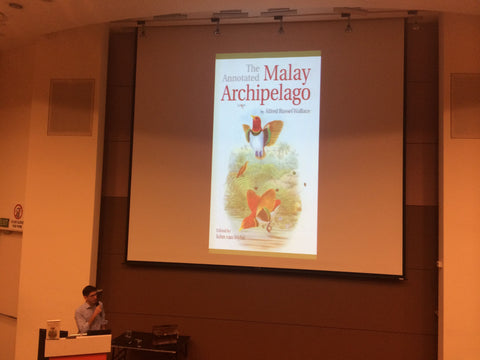
Wallace the “forgotten” hero: Why is Darwin more famous than Wallace?
Dr van Wyhe opened the lecture with the very question that many have recently posed in response to the independent discovery of natural selection by both Darwin and Wallace, namely – if this phenomenon was something that the pair had discovered (albeit separately), why is Darwin so much more famous than Wallace?
As an inquiry that began in the 1950s, this has since spiraled into claims – according to Dr van Wyhe – that Wallace was not only unjustly “forgotten” but also the “victim of a conspiracy”. Some have even put forward that Darwin had plagiarized Wallace’s work. In fact, the more books are written about Wallace, the more firmly his status as a “forgotten” hero seems to be cemented, Dr van Wyhe observed. Exaggerated statements thus abound about Wallace being “the greatest field biologist”, and even Black Books comedian Bill Bailey has exclaimed with injustice that natural selection “was known as a joint theory [by Darwin and Wallace] for decades!”
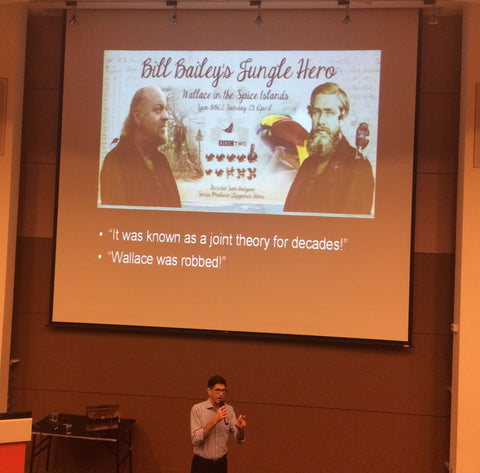
We might perceive Wallace to be unfairly left out of the limelight then, only because we have been told that this is so, Dr van Wyhe argued. Additionally, this “forgotten” descriptor of Wallace may perhaps have been arrived at with the false impression of Wallace’s relatively “humble background” that persuades one of his deserving better recognition. Wallace was certainly no peasant, having been sent to a school for gentlemen in his youth, for example.
The real, historical Wallace
If not a “forgotten” hero, who could the real Wallace be? After his school days and a voyage to the Amazon, Wallace arrived at Singapore in 1854, Dr van Wyhe delineated. It was here that Wallace made expeditions to Bukit Timah, trips which would form part of his material for The Malay Archipelago. Wallace’s influence as a naturalist still resounds among parts of the island today, with roads and nature trails named after him, for instance.
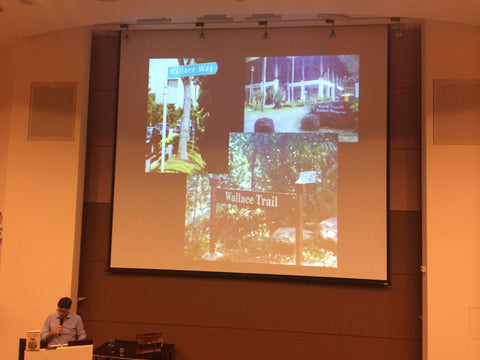
Southeast Asia was also where the idea of natural selection first came to Wallace in 1858. Penning down his thoughts on the subject, Wallace decided to first send these off to Darwin, who he felt would be sympathetic to ideas of such a nature. (These notions had previously also occurred to Darwin 20 years ago in 1838, though nothing had been published by him at that point.) Upon reception, the choice was made to have Darwin’s and Wallace’s ideas published together in a paper. However, very few took notice of this scholarship at that time.
With this piece of information, some might clamour again for the rightful recognition of Wallace’s role in discovering natural selection. Yet, more importantly, as Dr van Wyhe put it, the household recognition of only Darwin’s name today is quite simply because it was his book which had convinced people of the verity of natural selection. Wallace’s discovery notwithstanding, Darwin’s The Origin of Species still contained other numerous ideas that Wallace had never conceived of, a fact that the latter freely admitted to. Indeed, Wallace was even part of the flurry of voices commending Darwin’s unprecedented work at that time. Rounding things up, it may perhaps be more accurate then to view the Wallace-Darwin relationship as one filled not so much with animosity, but academic camaraderie, Dr van Wyhe concluded.
The Annotated Malay Archipelago is now available at NUS Press.
Philip Taylor wins 2015 Nikkei EuroSEAS Social Science Book Prize: Five NUS Press titles shortlisted August 19, 2015 16:40
We are pleased to announce that Philip Taylor has won the inaugural Nikkei EuroSEAS Social Science Book Prize awarded by the European Association for Southeast Asian Studies at a reception at the University of Vienna on 12 August 2015.
The Social Science Prize was awarded to Taylor for his The Khmer Lands of Vietnam: Environment, Cosmology and Sovereignty. "In this meticulous, absorbing and often poignant book, Philip Taylor draws on years of fieldwork to take us among the appealing, resilient and ecologically gifted Khmer speaking minority in southern Vietnam. This is the first book in any language to treat these beleaguered men, and women with the sustained, sympathetic attention that they deserve." - David Chandler

The prize was accepted on behalf of the author by Gerald Jackson, of NIAS Press, which co-published the European edition of the book. (You can just make him out in the photo at left...)
Khmer Lands was just one of five books originated by NUS Press which made the EuroSEAS shortlist, in both the social sciences and the humanities categories. We are greatly honoured by the nominations and would like to thank everyone for their continual support. The additional shortlisted titles are mentioned below:
Shortlisted for the Humanities Book Prize
 Surabaya, 1945-2010: Neighbourhood, state and economy in Indonesia’s city of struggle by Robbie Peters
Surabaya, 1945-2010: Neighbourhood, state and economy in Indonesia’s city of struggle by Robbie Peters
"This is a brilliant book, a must read for anybody wanting to understand the Asian city...Peters has written what I believe is the best study of any Indonesian kampung. Few scholars have managed to do such close and complex ethnographic and oral history research - gaining the trust of people from the lowest to the highest levels of a seemingly chaotic urban society." - Lea Jellinek
 Squatters into Citizens: the 1961 Bukit Ho Swee fire and the making of modern Singapore by Loh Kah Seng
Squatters into Citizens: the 1961 Bukit Ho Swee fire and the making of modern Singapore by Loh Kah Seng
"This excellent book - located at the intersection of history, ethnography and sociology - makes a major contribution to our understanding of the social history of post-war/post-colonial Singapore, and more generally to the interdisciplinary field of disaster studies." - James Francis Warren
Shortlisted for the Social Science Book Prize
 Mobilizing Gay Singapore: rights and resistance in an authoritarian state by Lynette J. Chua
Mobilizing Gay Singapore: rights and resistance in an authoritarian state by Lynette J. Chua
"Mobilizing Gay Singapore fills a void in foreigners’ understanding of gay issues in Singapore. It will remain for some time the standard work on the subject and is a very welcome addition to the LGBT canon."
- Nigel Collett
 Fields of Desire: poverty and policy in Laos by Holly High
Fields of Desire: poverty and policy in Laos by Holly High
"In this beautifully composed ethnography on poverty reduction programs in Laos, Holly High uncovers the ambivalence with which rural people regard state power. Her meditation on the ambiguity of desire in state-society relations is path-breaking and offers new insights into the nature of rural citizenship in Southeast Asia and beyond." - Philip Taylor
We are greatly honoured by the nominations and would like to thank everyone for their continual support.
Of Whales and Dinosaurs book talk with author Kevin Tan June 3, 2015 16:00
NUS Press held a book talk at the Lee Kong Chian Natural History Museum on 29 May 2015. Dr Kevin Tan, author of Of Whales and Dinosaurs: Singapore’s Natural History Museum, was present to give a talk about the museum's natural history collection.
Full house at NUS Press book event with Dr Kevin Tan
In his talk titled “Singapore’s Natural History Collection: A Perilous Prologue”, Dr Tan took the audience through the long and perilous 127-year history of the Raffles Zoological Reference Collection. He shared anecdotes of the brave individuals and past curators who managed to keep the collection mostly intact through two world wars, numerous financial and leadership crises, and the damning hand of modernisation and progress after Singapore’s independence.
Notably in 1942 when Singapore was occupied by Japan during World War II, the fate of its cultural heritage and natural history collections was uncertain. After Singapore’s surrender, E. J. H. Corner, the assistant director of the Botanic Gardens, had a “crazy idea” to “approach the Japanese to preserve the [collections]”. Dr Tan recounted how Corner approached the Japanese authorities with a note signed by the Governor to request them to protect the cultural properties.
Corner was joined by Hidezo Tanakadate, a professor from the University of Japan, who proclaimed that he had come to “conserve the cultural heritage”. Many years later it was discovered by Corner that Tanakadate had no real military authority to take over Singapore’s cultural heritage; he only had the rank of a sublieutenant. Dr Tan emphasised that it took the courage of such individuals who recognised the importance of the natural history collection and endeavoured to preserve it. The dedication and efforts of these stalwarts are duly recorded in Of Whales and Dinosaurs.
Mrs Yang Chang Man, former curator of the natural history collection, was also present at the book event to show her support. Mrs Yang and her team kept the collection from disintegration in the early 1970s when the government’s nation-building focus marginalised natural history and placed priorities elsewhere.

Dr Tan and Mrs Yang (both in pink) with the NUS Press team
During the Q&A session, Dr Tan took a question from an audience who asked about the legal protection for cultural heritage.
"I’m afraid there’s no real legal protection [in Singapore] but the [natural history] collection does belong to [National University of Singapore] now. I’m quite sure the university has insured the collection and I think it’s probably in the safest hand possible.”
Another audience posed the question on the possibility of retrieving the whale skeleton which was given to the National Museum in Kuala Lumpur in 1974. Dr Tan shared the possible legal and diplomatic complications in recovering the mounted whale skeleton:
“It’s not a problem of money if the [skeleton] is for sale because it is a matter of national pride. But it’s not so direct [to retrieve it back]…since the skeleton was given to the federal government, not to the state government.”
Dr Tan addressed the last question on the damage incurred by the collection before Lee Kong Chian Natural History Museum was established and the possibility of expansion for the new museum.
“Very little [of the collection] was actually lost, thanks to Mrs Yang [Chang Man] and her team. Specimens do deteriorate over time so you have to throw [them] away. That’s [inevitable] given our weather and the [poor storage conditions]...The museum did lose two of the biggest things: the whale skeleton (given to Malaysia) and the skeleton of the elephant which was shot by the Sultan of Johore in 1909.
...I’m sure there’s room for expansion. In fact the museum never ceases to grow. Many of the specimens here are post-1970s. The museum scientists continue to go on expeditions. In terms of biodiversity the sea life is richer and much more unexplored [in Singapore]...For instance the fish collection has grown a lot. Peter Ng, director of the museum, is also one of the leading experts in crabs so the crab collection is amazing.”
Thank you for your support for Of Whales and Dinosaurs. Do visit the Lee Kong Chian Natural History Museum to learn more about Singapore’s rich biodiversity and natural history.
NUS Press and author Peter Borschberg at KLRCA seminar April 15, 2015 10:00

NUS Press was delighted to attend Kuala Lumpur Regional Centre for Arbitration (KLRCA) seminar on 13 March 2015 titled 'The Reconciliation of Norms in International Relations'.
Represented by our distributor, we displayed three of our maritime classics: China as a Sea Power, 1127-1368: A Preliminary Survey of the Maritime Expansion and Naval Exploits of the Chinese People During the Southern Song and Yuan Periods, Hugo Grotius, the Portuguese and Free Trade in the East Indies and Pedra Branca: The Road to the World Court.
Peter Borschberg, author of Hugo Grotius, the Portuguese and Free Trade in the East Indies, shared the writings of Hugo Grotius and how Grotius shaped modern thinking and norms in international relations. Together with Professor Lee Poh Ping and Professor Anthony Milner, Peter led a discussion on the relevance of this historical experience to current contests in the Asia Pacific.
Watch the full coverage on the interesting talk below or on KLRCA youtube channel.


